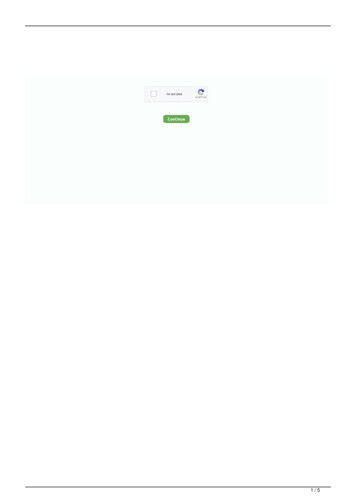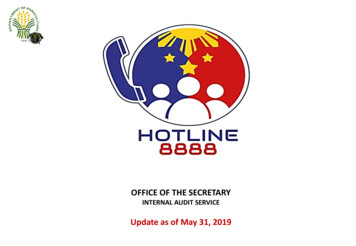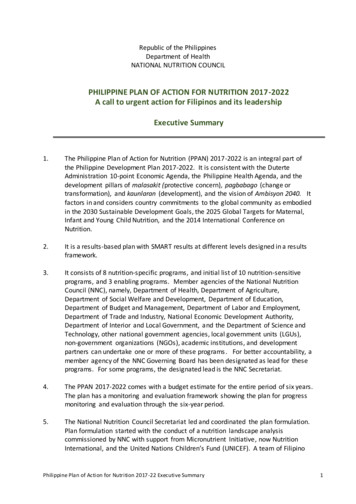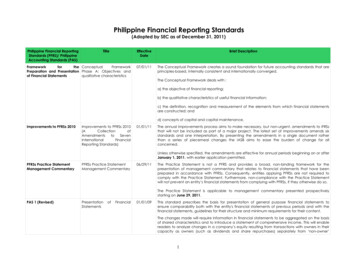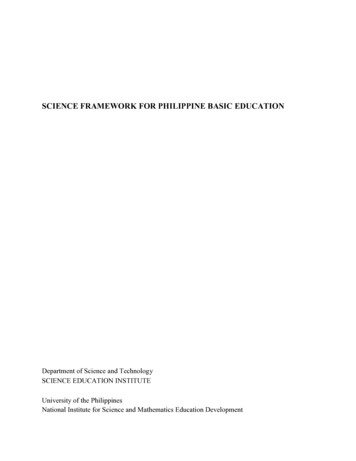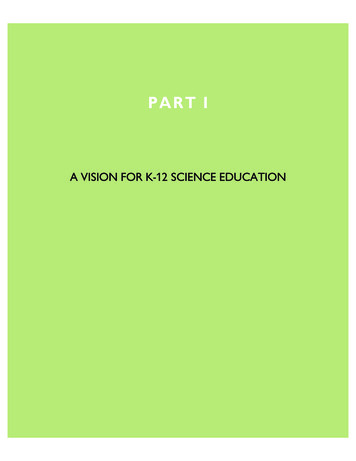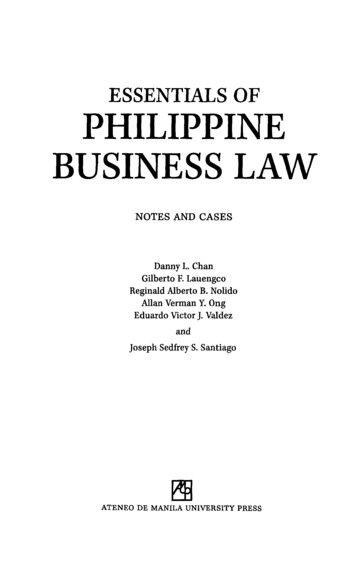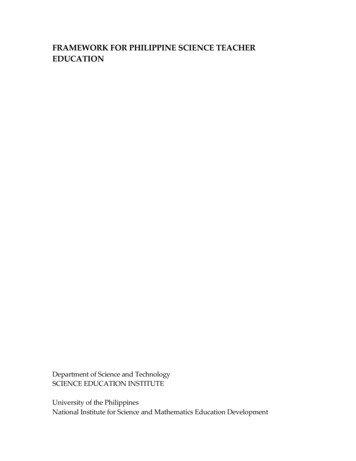
Transcription
FRAMEWORK FOR PHILIPPINE SCIENCE TEACHEREDUCATIONDepartment of Science and TechnologySCIENCE EDUCATION INSTITUTEUniversity of the PhilippinesNational Institute for Science and Mathematics Education Development
Framework for Philippine Science Teacher EducationAll rights reserved. 2011 by the Science Education Institute, Department of Science and Technology (SEI-DOST)and the University of the Philippines National Institute for Science and Mathematics Education Development(UP NISMED), Manila, PhilippinesCitation:SEI-DOST & UP NISMED, (2011). Framework for philippine science teacher education.Manila: SEI-DOST & UP NISMED.ISBN 978-971-8600-45-0Published by:Science Education Institute, Department of Science and Technology1st and 2nd Levels, Science Heritage BuildingDOST Compound, General Santos AvenueBicutan, Taguig City, Metro Manila, PhilippinesTel. Nos. (632) 837-1359, (632) 839-0241, Fax No. (632) 837-1924http://www.sei.dost.gov.ph / www.science-scholarships.ph andUniversity of the Philippines National Institute for Science and Mathematics Education DevelopmentE. Quirino Avenue, UP CampusDiliman, Quezon City 1101 PhilippinesTel. No. (632) 927-4276, Fax No. (632) 928-3545http://www.upd.edu.ph/ ismed/ e-mail: nismed@up.edu.phRequest for permission to use any material from this publication or for further information should beaddressed to the copyright holders.Printed in Metro Manila, Philippines
ForewordThis framework is the product of months of careful planning and discussions, with ideascoming from the best minds in the field of science, prior to the actual drafting of themanuscript. Although there may have been opposing views during the development ofthis framework, which is not unusual when experts meet, the final output is proof thatindividuals with diverse backgrounds and beliefs could be united by a common vision andgoal.The “Framework for Philippine Science Teacher Education” contains resources that will helpteacher education institutions, university science professors and school administratorsassess and improve the performance of science teachers using standards-based rubrics.The qualities of effective science teachers in terms of what they should know (knowledge),what they are expected to do to achieve quality learning outcomes (practice) and what theyshould possess to be able to embrace change and sustain professional growth (attributes)are also included. All these are anchored on the objective of raising the quality of scienceeducation.It is hoped that this framework will be widely used and applied by the variousstakeholders, and that together we will work towards achieving the desired goal ofeffective science teaching among our teachers.Dr. Filma G. BrawnerDirector, Science Education Institute
ContentsChapter 1. Introduction . . . . . . . . . . . . . . . . . . . . . . . . . . . . . . . . . . . . . . . . . . . . . . . . . . . . . . . . .1Mission of Schools and Teacher Education Programs . . . . . . . . . . . . . . . . . . . . . . . . . . . . . . 1Science Education in the Philippines: Challenges and Prospects . . . . . . . . . . . . . . . . . . . . . 1Reforms in Science Education: What Other Countries Are Up To . . . . . . . . . . . . . . . . . . . . 8Towards a Standards-based Science Teacher Education . . . . . . . . . . . . . . . . . . . . . . . . . . . . 10Chapter 2. Guiding Principles in the Developmentof the Framework for Science Teacher Education . . . . . . . . . . . . . . . . . . . . . . . . . 12Reviewed Documents . . . . . . . . . . . . . . . . . . . . . . . . . . . . . . . . . . . . . . . . . . . . . . . . . . . . . . . . . 12The Proposed Science Curriculum Framework for Basic Education . . . . . . . . . . . . . . .The National Competency-based Teacher Standards . . . . . . . . . . . . . . . . . . . . . . . . . . .The School-based Training Standards . . . . . . . . . . . . . . . . . . . . . . . . . . . . . . . . . . . . . . . .The Revised Policies and Standardsfor Undergraduate Teacher Education Curriculum (CMO 53 s 2005) . . . . . . . . . . . .The National Professional Standards for Highly Accomplished Teachers of Science . .1214151516The Guiding Principles in the Development of the FSTE . . . . . . . . . . . . . . . . . . . . . . . . . . . . . 16Chapter 3. Qualities of Effective Science Teachers . . . . . . . . . . . . . . . . . . . . . . . . . . . . . . . . . . . 18Professional Knowledge . . . . . . . . . . . . . . . . . . . . . . . . . . . . . . . . . . . . . . . . . . . . . . . . . . . . . . . 19Professional Practice . . . . . . . . . . . . . . . . . . . . . . . . . . . . . . . . . . . . . . . . . . . . . . . . . . . . . . . . . 22Professional Attributes . . . . . . . . . . . . . . . . . . . . . . . . . . . . . . . . . . . . . . . . . . . . . . . . . . . . . . . . 31Chapter 4. Evaluating the Performance of Science Teachers Using Standards-based Rubrics 35Rubrics for Professional Knowledge . . . . . . . . . . . . . . . . . . . . . . . . . . . . . . . . . . . . . . . . . . . . 37Rubrics for Professional Practice . . . . . . . . . . . . . . . . . . . . . . . . . . . . . . . . . . . . . . . . . . . . . . . 38Rubrics for Professional Attributes . . . . . . . . . . . . . . . . . . . . . . . . . . . . . . . . . . . . . . . . . . . . . 40Chapter 5. Continuing Professional Development for Science Teachers . . . . . . . . . . . . . . . . . 42Professional Development Programs for Practicing Teachers (INSET) . . . . . . . . . . . . . . . . . 43Suggested Revisions for BEED and BSED Program, Major in Science . . . . . . . . . . . . . . . . . . 48References . . . . . . . . . . . . . . . . . . . . . . . . . . . . . . . . . . . . . . . . . . . . . . . . . . . . . . . . . . . . . . . . . . . . . 52Appendices1 National Competency-based Teacher Standards2 Tartu Declaration of Science and Technology
CHAPTER 1IntroductionThe mission of schools is to educate children to higher standards ofperformance by providing them with the experiences necessary to learn, define,analyze, adapt and invent. This statement was made in 1994 by Linda DarlingHammond, Executive Director of the National Commission on Teaching andAmerica's Future.Mission of Schools and Teacher Education ProgramsThis same mission is echoed by schools not only in the Philippines but allover the world. The Hammond Report also emphasized that teachers who willsuccessfully carry out this mission need to be well-prepared and well-equipped.They need to be grounded deeply in subject matter, knowledge of children'scognitive, social and personal development, and learning and motivation. Inaddition, they should have deep-rooted knowledge of varied approaches toteaching strategies, collaborative learning techniques, creative ways to implementthe curriculum and use technology tools as well as effective assessment practices.Raising the learning standards can be achieved through a responsive teacherpreparation program and continuing professional development program for allpracticing teachers.Science Education in the Philippines: Challenges and ProspectsIn the Philippines, recent efforts have been directed to improving scienceeducation, both at the basic and teacher education levels. Research shows that the
quality of science education in schools is greatly influenced by the quality of scienceteachers. Students’ interest in science is directly linked to the quality of teaching aswell as learning interactions provided by their science teachers. Interviews withstudents who excelled in science reveal that they were greatly inspired by scienceteachers who engaged them in tasks that enabled them to inquire and solveproblems.Science has a rapidly changing knowledge base and expanding relevance tosociety. Teachers must pursue opportunities to build their understanding of howstudents with varied interests, abilities, and experiences can be supported andguided. Subsequently, students may be able to make sense clearly out of scientificideas. These ideas can be linked to real-life situations. Furthermore, science teachersmust have the chance to conduct research in regard to science teaching andlearning, and to share the results of their studies with their colleagues.Science teachers who manage to develop students’ skills in searching foranswers to questions about materials and phenomena in the environment, andthose who empower their students to grow to become informed decision makers insociety, are considered effective teachers. These teachers are also able to evaluatetheir own practice and use these insights to develop challenging learner-centeredexperiences. In effect, a committed science teacher should be reflective,collaborative, and a lifelong learner.There are many constraints facing science education in Philippine schools:shortage of qualified science teachers, lack of quality textbooks, inadequateequipment, large classes, lack of support from administrators, and many others.However, the Core and Technical Working Groups for this project decided that theframework for science teacher education should pay attention to problems that willaddress ways to improve or raise the quality of teaching practices, and personalattributes.Challenge 1: Shortage of qualified science teachersIn 2004, Garcia and Tan prepared a report on Project RISE (Rescue Initiativesin Science Education). The report describes qualified teachers as follows:FRAMEWORK FOR PHILIPPINE SCIENCE TEACHER EDUCATION2
1. Those who have specialization in any science discipline (e.g., biology,chemistry, physics, and general science) in their undergraduatedegrees;2. Those who have undergone in-service training programs in the variedscience disciplines equivalent to a major or minor; and3. Those with degrees in science-related professions (e.g., engineers,pharmacists, nutritionists, and nurses) who opted to go into teaching atthe basic education level, took 18 units of foundation educationsubjects, and passed the licensure examination for teachers.Despite these broad categories, qualified science teachers are still lacking inthe country, based on a number of reasons.Firstly, the Bachelor of Elementary Education (BEED) curriculum did notrequire students to specialize in any subject area. As of 2003, CMO No. 9 requiredBEED students to take only 6-9 units of science courses. In 2005, the New TeacherEducation Curriculum was introduced (CMO No. 30). The content courses forBEED totals 57 units but only 12 units of these are in Science.Table 1: Offerings under the 2005 Teacher Education CurriculumAreasGeneral EducationProfessional EducationSpecialization (Content)TotalBEED (units)BSED (units)63(Science: 9 units)5463(Science : 9 units)5157(Science: GE 3 units)17460(Science: all 60 units)174On the other hand, students enrolled in the Bachelor in SecondaryEducation (BSED) program are required to have a major and/or minor in any of thefollowing science subjects:General Science, Biology, Chemistry, Physics, orMathematics. In this new curriculum, students take 60 units of science subjects.However, not many teacher education institutions (TEI) in the country offerFRAMEWORK FOR PHILIPPINE SCIENCE TEACHER EDUCATION3
specialization subjects in science (CHED, 2006) and the number of studentsmajoring in science education is small (DOST, 2002).Based on personalcommunications with deans of colleges of education of state universities, thenumber of students enrolled in science education remains low.Secondly, Project RISE (1999-2003) was discontinued due to lack of fundswhile the quality of training modeled in the Science and Mathematics EducationManpower Development Project (SMEMDP, 1994-1999) was not sustained ascascading models of training were implemented. Regional and district trainingprograms were shorter in duration and, therefore, less intensive, vis-à-vis nationaltraining programs.Thirdly, instead of specializing in science education, many science teacherstend to specialize in Administration and Supervision or Research and Evaluation.A DOST-SEI study in 2002 revealed that many classroom teachers would rather bepromoted as school administrators. Ironically, the rate of principals and masterteachers are within the same salary range.Finally, the dwindling number of qualified science teachers is worsened bythe brain drain phenomenon. Cortes, Tan, and Savellano (2005) reported that since1990, more than twelve thousand science and mathematics teachers left thePhilippines to seek better opportunities in the United States, Canada, and othercountries. Filipinos with master’s and doctoral degrees in Science and MathematicsEducation are in demand overseas. In particular, industrialized countries have beenaggressive and persistent in recruiting highly qualified Filipino science andmathematics teachers.Challenge 2: Incongruent teaching assignments with teachers’educational backgroundLack of qualified science teachers in many schools leads to the practice ofassigning teachers to teach science subjects despite their limited background. Thissituation is true for both elementary and secondary schools. UP NISMED studiedthe profile of participants in their training programs through the years and foundout that many teachers handling science subjects are nonscience majors. Whenasked what topics do they find difficult to teach or students have difficultyFRAMEWORK FOR PHILIPPINE SCIENCE TEACHER EDUCATION4
understanding the concepts, they included electricity, chemical changes andreactions, weather, plate tectonics, and movement of heavenly bodies. These topicsrequire a lot of visualization and use of models because the concepts are abstract.Lacking in confidence to teach these science subjects, teachers tend to focus orlinger on topics they are familiar with (usually biological) and leave out the difficultones.One probable effect of this practice is the low performance of students ininternational and national assessment studies. The results of the TrendsInternational Science and Mathematics Study (TIMSS, 1999 and 2003) and theNational Achievement Test (Department of Education, 2003-2008) support thisobservation. Although there had been increases in the performance of students inNAT 2007 and 2008, the national mean percent score is still below mastery level.UP NISMED reported a disturbing situation when it evaluated the impact ofBridgeit or Text-2-Teach Project which was implemented in three regions (Region 4,Region 12, and the National Capital Region) in 2004.The project, sponsored byNokia and International Youth Foundation through SEAMEO-INNOTECH,provided interactive, easy-to-use multimedia packages to make science learninginteresting and meaningful for young learners. The UP NISMED study revealedthat there was no significant difference between Grades 5 and Grades 6 students inregard to what they know and can do in science. One reason that was used toaccount for this observation is the inadequate preparation of teachers handlingscience subjects. Grade 6 Science has more abstract concepts and higher orderthinking skills requirement than Grade 5 Science. Thus, it can be inferred thatteachers’ science content background is not enough to deal with abstract conceptsin a higher grade science subject.Most alarming is the result of the analysis of the TIMSS tests given toteachers of students who took the test in 2003. It was discovered that, on theaverage, the highest scoring students fared better than the teacher. The tests alsorevealed that many science teachers and students are incapable of assessing itemsthat fall under conceptual understanding and analysis/reasoning, especially itemsunder the constructed-response type. The 2003 TIMSS test covered concepts inBiology, Chemistry, Physics, Earth Sciences, Environmental Science, and theFRAMEWORK FOR PHILIPPINE SCIENCE TEACHER EDUCATION5
Nature of Science while the teachers who took the test were teaching Grade 4Science in elementary school and Biology in secondary school.Challenge 3: Predominance of teacher-centered classrooms andteaching practicesTeaching science through the transmission approach is still predominant. Inthis approach, the teacher manages the learning and passes onto learners theknowledge and skills, treating them as ‘empty vessels which the teacher fills’.There is evidence that transmission approach to learning, especially inelementary school, may be contributing to the lack of interest in science that is nowwidespread among elementary and secondary schools students across the country.The low percentage of students venturing into science-related careers in tertiaryeducation can be attributed to the poor quality of science teaching in manyPhilippine secondary schools.For many years, learner-centered classes have been found effective indeveloping students’ critical and creative thinking skills. The approach is based onthe philosophy that students learn best when they hear, see, and manipulatevariables (also referred to as interactive learning). Consequently, the method bywhich learning occurs is oftentimes experiential. For many years, trainingprograms zeroed in on the use of practical work approach (PWA) to teaching andlearning. This approach requires science teachers to use hands-on and minds-onactivities to stimulate students’ curiosity and imagination. In a learner-centeredclassroom, the teacher’s role is to facilitate cognitive growth by utilizing the interestand unique needs of students as a guide to meaningful learning. Students’ learningis then evaluated based on predetermined and developmentally orientedobjectives.Sadly, teacher-centered classes still prevail in many Philippine schools.Lacking in content and pedagogical skills suitable for science teaching, manyscience teachers turn to lecturing instead of providing students with engaging andchallenging activities that enable the latter to develop creative ideas. Oftentimes,science teaching is still textbook-based and, more often than not, concepts are notFRAMEWORK FOR PHILIPPINE SCIENCE TEACHER EDUCATION6
relevant to daily life or the community. According to many students, “science isboring and irrelevant” (Ogena & Tan, BESRA KRT 3 Report, 2006). Small groupactivities are performed by students but many teachers do not adequately processthe results of these activities. Lesson plans are most often based on only onecompetency. The teaching and learning episodes are isolated (UP NISMED,OVCRD Report, 2010). Analysis of the competency list of DepED revealed that agroup of related competencies can be developed with fewer sessions, allotting timefor enrichment activities that develop in-depth understanding of content andacquisition of higher order thinking skills.Assessment of student learning is still predominantly at the factualknowledge level. Sample tests reviewed attest to this. Use of open-ended questionsis not common. The result of the assessment is not used to improve teaching. It hasto be recognized that ‘what gets assessed is what gets learned’ and goodassessment translates to good teaching.Challenge 4: Lack of quality textbooksIn the last few years, controversies over errors and inaccuracies in manytextbooks, including science books, created a lot of noise. Since textbooks may bethe only reference materials used by students and teachers, science teaching inPhilippine schools remains problematic. Misconceptions are being passed on fromtextbook to teachers and students, making them difficult to unlearn.The process of textbook development has changed. In the past, textbookchapters and activities were written, tried out, and revised based on feedback fromthe end users. This process took almost two years before a commercial edition isreleased. The tryout ensures that the language and content are suitable to thecognitive levels of students and errors are detected. Today, textbooks do notundergo trial in schools. Many activities in the Student Manual or Workbook donot work and substantial amount of errors have been discovered.In addition, the coverage of the textbooks and teacher guides are waybeyond what elementary and secondary school students can finish in one year.Because these topics are covered by the achievement tests, teachers go hurriedlythrough the chapters. More often than not, teachers tend to mimic what is writtenFRAMEWORK FOR PHILIPPINE SCIENCE TEACHER EDUCATION7
in the textbook instead of explaining the concepts in depth vis-à-vis theirapplications and connections to real-life situations.Challenge 5: The philosophy of science education at the basic educationlevel is NOT clearly defined and reflected in the teachereducation curriculumThe current science education curriculum for basic education is stilldescribed by local and foreign science educators as overloaded, discipline-based,and more useful for the college-bound. The science curriculum puts emphasis onbreadth rather than depth. Science subjects like Chemistry and Physics are taughtwith a sense of abstraction and a mathematical emphasis so that many students seethem as unnecessarily irrelevant and difficult. This situation contradicts the needsof the large percentage of Filipino students who drop out of school in differentgrade or year levels (Mateo, 2006; Lapus, 2007) as well as the goal of scienceeducation at the elementary and secondary level, that is, to develop science literatesand productive members of society (ICASE-UNESCO, 1993; Perth Declaration,2007).Over the past few years, several revisions of the Basic Education Curriculumof DepED were completed and implemented. While pilot testing had been done,results of the testing were not communicated to or shared with stakeholders. Inaddition, preservice students learn about the basic education curriculum only whenthey do practice teaching or when they have been admitted to the teaching force.Reforms in Science Education: What Other Countries Are Up ToThe problems and issues cited above (e.g., shortage of qualified scienceteachers, lack of quality textbooks, the discipline-based curriculum for basiceducation, and predominance of teacher-centered classrooms) necessitateeducational reforms and actions that will address the compelling need for studentsand the larger Philippine society to be influenced strongly by science andtechnology.Teaching for scientific literacy requires that science in basic educationshould be taught in an integrated manner. Ideally, it should not be taught byFRAMEWORK FOR PHILIPPINE SCIENCE TEACHER EDUCATION8
discipline. Many studies indicate that, for all students, the purpose of science at thebasic education level should be on developing scientific literacy for informedcitizenry or what other science educators term as Science for Citizenship (Fensham,2007). Many developed countries have reformed their curriculum towards thispurpose (e.g., New Zealand, Australia, and Japan). A recent curriculum reform(called 21st Century Science) from York University in England introducesFoundation Science as those subjects to be taken by all students, and AdditionalScience an optional subject, for those students who wish to go on with disciplinarysciences in later years. Considering the demands that Science makes on citizens inincreasingly S&T-influenced societies, Foundation Science trains students tobecome scientifically literate and equips them with scientific competenciesimportant to real-life contexts that involve science and technology. Australia’sscience curriculum for basic education (2010) focuses on inquiry teaching—thecourse content has been reduced to elements that are considered widely assignificant to students’ lives.A number of international meetings have released statements (e.g., PenangDeclaration in 2004, Perth Declaration in 2007, and Tartu Declaration of 2010) toguide governments in revising and framing their science curriculum. In principle,the teaching of science courses should address the needs of all students. But thosewho are intending to pursue careers in science and its related disciplines shouldreceive more intensive training. Statements from Penang, Perth and Tartu confirmthe need for scientific knowledge to be presented in terms of its practical usefulnessand exciting developments.This way, science can be seen by students as awonderful discipline because it enables them to understand and appreciatephenomena (e.g., weather, pollution, or catching diseases) better as they are studiedholistically, and not as compartmentalized applications of the different sciences.In order for teachers to teach with scientific literacy as a primary agenda,preservice education programs should be reformed. In addition, continuingprofessional development program (CPD) for practicing teachers should beinstitutionalized. The CPD program should promote the aim of science educationat the basic education level. These programs should be based on standards ofperformance to enable preservice and inservice teachers to enhance theirprofessional knowledge (knowledge of science content, knowledge of how to teachFRAMEWORK FOR PHILIPPINE SCIENCE TEACHER EDUCATION9
these content in more effective ways, and knowledge of the science curriculum),professional practices (ways to achieve quality learning outcomes), andprofessional attributes (characteristics that enable teachers to embrace change todevelop and improve teaching practice as well as sustain professional growth).In addition, the teacher education programs should include experiences inteaching science in an integrated and spiral manner. If we require students tomaster science concepts across disciplines, basic education teachers should also berequired to do just as well. Integrated teaching provides teachers with a wide arrayof concepts and skills in the basic sciences. It also makes them scientifically literate.Towards a Standards-based Science Teacher EducationIn 2006, a set of National Competency-Based Teacher Standards (NCBTS)was formulated under the Basic Education Sector Reform Agenda (BESRA Report,KRT2, 2006). The standards described are applicable to all teachers, regardless ofsubject area. The competencies are in Appendix 1.However, it has to be recognized that expertise in teaching is specific toparticular subjects and levels.The knowledge and skills of effective scienceteachers differ in many respects vis-à-vis the knowledge and skills of teachers ofmathematics or language. Therefore, the nature of professional developmentprograms for science teachers must also differ from those of the other subject areateachers.The proposed framework for science teacher education (FSTE) attempts tocapture the nature of professional development required to develop effectivescience teachers. The framework includes a list of behaviors that serves as thecriteria for making judgments about the quality of professional developmentopportunities that elementary and secondary school science teachers will need.These behaviors may be considered standards of performance of what an effectivescience teacher should know and be able to do.The framework and its standards can serve as a guide for teachers to reflecton their current teaching practices, establish new practices, and perform selfassessment so that they can plan their professional growth. The standards will alsoFRAMEWORK FOR PHILIPPINE SCIENCE TEACHER EDUCATION10
serve as a reference point every time teachers discuss concepts and teachingpractices with colleagues and school administrators. Science teacher educators andpreservice students can use the standards for clarifying areas where they canimprove more.School administrators can employ the standards for hiring, promoting,and/or supervising teachers. Professional development service providers can usethe standards as basis for designing programs for continuing professional learningof teachers. Furthermore, accrediting agencies like the Philippine RegulationsCommission can use the standards to develop assessment items for the LicensureExamination of Teachers. Finally, the framework can also serve as a guide for theCommission on Higher Education (CHED) in formulating appropriate legislationsas well as in allocating resources to support quality science teachers’ education.FRAMEWORK FOR PHILIPPINE SCIENCE TEACHER EDUCATION11
CHAPTER 2Guiding Principles in the Developmentof the Framework for Science Teacher EducationSeveral documents were used to guide the development of the FSTE: theProposed Science Curriculum Framework for Basic Education, the NationalCompetency-Based Standards, the School-Based Training Standards, the RevisedPolicies and Standards for Undergraduate Teacher Education Curriculum, and theNational Professional Standards of Highly Accomplished Teachers of Scienceprepared by the Australian Science Teachers Association. Relevant articles fromthe National Commission on Teaching and America's Future were also referred towhen formulating the guiding principles.Reviewed DocumentsThe Proposed Science Curriculum Framework for Basic EducationThe proposed SCFBE shows a much deloaded curriculum - focused ondepth rather than on breadth. Three major areas are emphasized: content of scienceand its connections, inquiry skills, and scientific attitudes (Figure 1). The choice oftopics/concepts is based on their relevance and applications to everyday life,arranged in a spiral manner from G1-10 to show increasing complexity of conceptsbased on three science areas: Life Science, Physical Science, and Earth and SpaceScience. The SCFBE shows how concepts within sciences and across subject areasare integrated. It highlights the thinking skills required to learn these concepts. Thegoal is scientific literacy for everyday life and gives emphasizes on acquiring andmaintaining good health, using energy wisely and coping with changes, andprotecting and conserving the environment and its natural resources.FRAMEWORK FOR PHILIPPINE SCIENCE TEACHER EDUCATION12
Inquiry lyliterate individualsScientific AttitudesFigure 1: SCFBE diagramThe proposed SCFBE adapts the philosophy that s
framework for science teacher education s hould pay attention to problems that will address ways to improve or raise the quality of teaching practices, and personal attributes. Challenge 1: Shortage of qualified science teachers In 2004, Garcia and Tan prepared a report on Project RISE (Rescue
